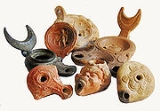
Oil lamp
Encyclopedia

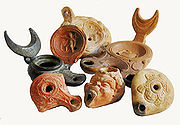
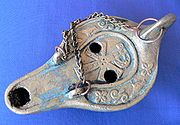
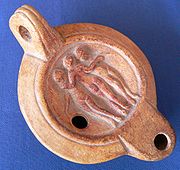
Oil lamps are a form of lighting, and were used as an alternative to candles before the use of electric lights. Starting in 1780 the Argand lamp
Argand lamp
The Argand lamp is home lighting oil lamp producing a light output of 6 to 10 candlepower which was invented and patented in 1780 by Aimé Argand...
quickly replaced other oil lamps still in their basic ancient form. These were, in turn, replaced by the kerosene lamp
Kerosene lamp
The kerosene lamp is a type of lighting device that uses kerosene as a fuel. This article refers to kerosene lamps that have a wick and a tall glass chimney. Kerosene lanterns that have a wick and a glass globe are related to kerosene lamps and are included here as well...
in about 1850. In small towns and rural areas these continued in use well into the 20th century, until such areas were finally electrified
Electrification
Electrification originally referred to the build out of the electrical generating and distribution systems which occurred in the United States, England and other countries from the mid 1880's until around 1940 and is in progress in developing countries. This also included the change over from line...
, and light bulbs could be used for lighting.
Most modern lamps (such as lanterns) have been replaced with gas-based
Propane
Propane is a three-carbon alkane with the molecular formula , normally a gas, but compressible to a transportable liquid. A by-product of natural gas processing and petroleum refining, it is commonly used as a fuel for engines, oxy-gas torches, barbecues, portable stoves, and residential central...
or petroleum-based fuels as they are safer to operate when emergency non-electric light is required. As such, oil lamps of today are primarily used for the particular ambience they produce, or in rituals and religious ceremonies.
Structure and function
Oil lamps were used not only for household lighting, but also for funerary and votive purposes. Lamps were used for domestic purposes in homes and for public purposes in temples and most public buildings.By studying the lamp's designs, symbols, structure and decorations, and the material of which it is made, we can identify the age and perhaps the locality of the lamp. The lamp can also give us insights into the culture of its users and their social status.
Occasionally the design of the lamps also mimics the female reproductive system. Indian bronze lamps with a protruding central portion are supposed to project the male genitalia on a female womb with light representing 'origin of life' in most cases.
Components
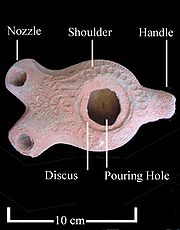
- Shoulder
- Pouring hole
- The hole through which fuel is put inside the fuel chamber. The width ranges from 0.5-5 cm in general. There may be single or multiple holes.
- Pick hole, and the nozzle.
- It may be just an opening in the body of the lamp, or an elongated nozzle. In some specific types of lamps there is a groove on the superior aspect of the nozzle that runs to the pouring hole to collect back the oozing oil from the wick.
- Handle
- Lamps come with and without a handle. The handle comes in different shapes. The most common is ring shaped for the forefinger surmounted by a palmettePalmetteThe palmette is a motif in decorative art which, in its most characteristic expression, resembles the fan-shaped leaves of a palm tree. It has an extremely long history, originating in Ancient Egypt with a subsequent development through the art of most of Eurasia, often in forms that bear...
on which the thumb is pressed to stabilize the lamp. Other handles are crescent shaped, triangular and semi-oval. The handleless lamps usually have an elongated nozzle, and sometimes have a lugLug (knob)A Lug is a typically flattened protuberance, a knob, or extrusion on the side of a vessel: pottery, jug, glass, vase, etc. They are sometimes found on prehistoric ceramics/stone-vessels such as pots from Ancient Egypt, Hembury ware, claw beakers, and boar spears.A lug may also only be shaped as a...
rising diagonally from the periphery. The lug may act as a small handle where the thumb rests. Some lugs are pierced. It was speculated that pierced lugs were used to place a pen or straw, called the acus or festuca, with which the wick was trimmed. Others think that the pierced lugs were used to hang the lamp with a metal hook when not in use.- Discus
- VoluteVoluteA volute is a spiral scroll-like ornament that forms the basis of the Ionic order, found in the capital of the Ionic column. It was later incorporated into Corinthian order and Composite column capitals...
- Fuel chamber
- The fuel reservoir. The mean volume in a typical terra-cotta lamp is 20 cc.
Wicks
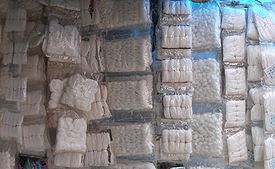
Candle wick
A candle wick is a string, cord, or wooden object that holds the flame of a candle. A candle wick works by capillary action, drawing the fuel to the flame. When the liquid fuel, typically melted candle wax, reaches the flame it then vaporizes and combusts. The candle wick influences how the...
is placed over the nozzle and extends into the fuel chamber. Most lamps come with one nozzle; a few lamps have more, from two to twenty nozzles. However, the more nozzles, the greater the fuel consumption.
The wick was made of different materials, linen
Linen
Linen is a textile made from the fibers of the flax plant, Linum usitatissimum. Linen is labor-intensive to manufacture, but when it is made into garments, it is valued for its exceptional coolness and freshness in hot weather....
, flax
Flax
Flax is a member of the genus Linum in the family Linaceae. It is native to the region extending from the eastern Mediterranean to India and was probably first domesticated in the Fertile Crescent...
, papyrus
Papyrus
Papyrus is a thick paper-like material produced from the pith of the papyrus plant, Cyperus papyrus, a wetland sedge that was once abundant in the Nile Delta of Egypt....
, tow
Tow
In the composites industry, a tow is an untwisted bundle of continuous filaments, and it refers to man-made fibres, particularly carbon fibres ....
, or ordinary rush
Juncaceae
Juncaceae, the rush family, are a monocotyledonous family of flowering plants. There are eight genera and about 400 species. Members of the Juncaceae are slow-growing, rhizomatous, herbaceous plants, and they may superficially resemble grasses. They often grow on infertile soils in a wide range...
. The thickness of the wick is an important factor too; thin wicks burn fuel more slowly than thick ones. However, the thickness of the wick does not have much effect on the size of the flame.
Fuel
Fuels used for oil lamps depend on such variables as the location, time period and perhaps the reason for the lamp's use; ceremonial use of lamps for instance may require a particular oil or fragrance to be used. The main fuel in Western nations was olive oilOlive oil
Olive oil is an oil obtained from the olive , a traditional tree crop of the Mediterranean Basin. It is commonly used in cooking, cosmetics, pharmaceuticals, and soaps and as a fuel for traditional oil lamps...
in ancient Mediterranean cultures, though extracts from fish, crude fish oil
Fish oil
Fish oil is oil derived from the tissues of oily fish. Fish oils contain the omega-3 fatty acids eicosapentaenoic acid , and docosahexaenoic acid , precursors of certain eicosanoids that are known to reduce inflammation throughout the body, and are thought to have many health benefits.Fish do not...
, nut
Nut (fruit)
A nut is a hard-shelled fruit of some plants having an indehiscent seed. While a wide variety of dried seeds and fruits are called nuts in English, only a certain number of them are considered by biologists to be true nuts...
s, and cheese were also used. In much later times whale oil
Whale oil
Whale oil is the oil obtained from the blubber of various species of whales, particularly the three species of right whale and the bowhead whale prior to the modern era, as well as several other species of baleen whale...
was favoured for its cleaner burning flame. Oozing crude petroleum was also used. The fuel was poured into the fuel reservoir via the pouring hole in the discus.
Castor oil
Castor oil
Castor oil is a vegetable oil obtained from the castor bean . Castor oil is a colorless to very pale yellow liquid with mild or no odor or taste. Its boiling point is and its density is 961 kg/m3...
was used by the ancient Egyptians. In Africa
Africa
Africa is the world's second largest and second most populous continent, after Asia. At about 30.2 million km² including adjacent islands, it covers 6% of the Earth's total surface area and 20.4% of the total land area...
, carrot oil, peanut oil
Peanut oil
Peanut oil is an organic material oil derived from peanuts, noted to have the aroma and taste of its parent legume....
, mustard oil
Mustard oil
The term mustard oil is used for three different oils that are made from mustard seeds:*A fatty vegetable oil resulting from pressing the seeds,...
and nettle oil are used. India
India
India , officially the Republic of India , is a country in South Asia. It is the seventh-largest country by geographical area, the second-most populous country with over 1.2 billion people, and the most populous democracy in the world...
n lamps, especially for use in puja
Puja (Buddhism)
In Buddhism, puja are expressions of "honour, worship and devotional attention." Acts of puja include bowing, making offerings and chanting...
, almost exclusively use ghee
Ghee
Ghee is a class of clarified butter that originated in South Asia and is commonly used in South Asian cuisine....
as fuel.
Among other fuels used have been coal oil
Coal oil
Coal oil is a term once used for a specific shale oil used for illuminating purposes. Coal oil is obtained from the destructive distillation of cannel coal, mineral wax, and bituminous shale, while kerosene is obtained by the distillation of petroleum...
and paraffin
Paraffin
In chemistry, paraffin is a term that can be used synonymously with "alkane", indicating hydrocarbons with the general formula CnH2n+2. Paraffin wax refers to a mixture of alkanes that falls within the 20 ≤ n ≤ 40 range; they are found in the solid state at room temperature and begin to enter the...
/kerosene
Kerosene
Kerosene, sometimes spelled kerosine in scientific and industrial usage, also known as paraffin or paraffin oil in the United Kingdom, Hong Kong, Ireland and South Africa, is a combustible hydrocarbon liquid. The name is derived from Greek keros...
in paraffin lamps (also called kerosene lamp
Kerosene lamp
The kerosene lamp is a type of lighting device that uses kerosene as a fuel. This article refers to kerosene lamps that have a wick and a tall glass chimney. Kerosene lanterns that have a wick and a glass globe are related to kerosene lamps and are included here as well...
s and coal oil lamps).
Oil lamps can use many other fuels including jathropa seed oil and biodiesel along with wvo, soybean oil, canola oil, hemp seed oil, sunflower seed oil, and olive oil.
Lamps were usually put in lamp holders when in use, partly to avoid the risk of fire. They might be fastened to a wall by a nail or a wooden wedge, hung suspended from brackets, placed in a candelabra, placed in niches in the wall, put on lamp stands of different shapes, or carved as part of stone lamp pillars.
Production methods
Before the invention of the wheelWheel
A wheel is a device that allows heavy objects to be moved easily through rotating on an axle through its center, facilitating movement or transportation while supporting a load, or performing labor in machines. Common examples found in transport applications. A wheel, together with an axle,...
in the Middle Bronze Age, lamps were made by hand. An early form of the potter’s wheel was invented and introduced in the Middle Bronze Age and used to manufacture lamps until around the 3rd century BCE. The use of molds was first developed in Greece
Greece
Greece , officially the Hellenic Republic , and historically Hellas or the Republic of Greece in English, is a country in southeastern Europe....
and Egypt
Egypt
Egypt , officially the Arab Republic of Egypt, Arabic: , is a country mainly in North Africa, with the Sinai Peninsula forming a land bridge in Southwest Asia. Egypt is thus a transcontinental country, and a major power in Africa, the Mediterranean Basin, the Middle East and the Muslim world...
during the 3rd century BCE. In Roman
Ancient Rome
Ancient Rome was a thriving civilization that grew on the Italian Peninsula as early as the 8th century BC. Located along the Mediterranean Sea and centered on the city of Rome, it expanded to one of the largest empires in the ancient world....
times, stone
Rock (geology)
In geology, rock or stone is a naturally occurring solid aggregate of minerals and/or mineraloids.The Earth's outer solid layer, the lithosphere, is made of rock. In general rocks are of three types, namely, igneous, sedimentary, and metamorphic...
, clay
Clay
Clay is a general term including many combinations of one or more clay minerals with traces of metal oxides and organic matter. Geologic clay deposits are mostly composed of phyllosilicate minerals containing variable amounts of water trapped in the mineral structure.- Formation :Clay minerals...
, or plaster
Plaster
Plaster is a building material used for coating walls and ceilings. Plaster starts as a dry powder similar to mortar or cement and like those materials it is mixed with water to form a paste which liberates heat and then hardens. Unlike mortar and cement, plaster remains quite soft after setting,...
molds were utilized on a large scale across the Roman Empire
Roman Empire
The Roman Empire was the post-Republican period of the ancient Roman civilization, characterised by an autocratic form of government and large territorial holdings in Europe and around the Mediterranean....
until around the 8th century CE.
To make a lamp, two moulds are needed: one for the upper part and one for the lower part. Some pairs of moulds have knobs and corresponding holes to fit the two molds together. In order to create the mold, an archetype or patrix is first made. Plaster or clay is then formed around the patrix, which dries and hardens into a mould. Clay moulds are removed from the patrix before they are fully dried. They are then kiln
Kiln
A kiln is a thermally insulated chamber, or oven, in which a controlled temperature regime is produced. Uses include the hardening, burning or drying of materials...
fired, thus they may deviate or shrink from their original form. Clay moulds need more labour than plaster ones. However, clay moulds are more durable. Plaster moulds are dried completely and then removed from the patrix. Plaster thus makes an accurate replica, but it has the disadvantage of leaving some surface granular artifacts. Due to the perishable nature of plaster, it has proven difficult to find remains of ancient plaster moulds. Several clay moulds, however, have been recovered. By studying the surfaces of surviving lamps it seems that plaster was preferred to clay.
Lamp typology
Lamps can be categorized based on different criteria, including material (ClayClay
Clay is a general term including many combinations of one or more clay minerals with traces of metal oxides and organic matter. Geologic clay deposits are mostly composed of phyllosilicate minerals containing variable amounts of water trapped in the mineral structure.- Formation :Clay minerals...
, Silver
Silver
Silver is a metallic chemical element with the chemical symbol Ag and atomic number 47. A soft, white, lustrous transition metal, it has the highest electrical conductivity of any element and the highest thermal conductivity of any metal...
, Bronze
Bronze
Bronze is a metal alloy consisting primarily of copper, usually with tin as the main additive. It is hard and brittle, and it was particularly significant in antiquity, so much so that the Bronze Age was named after the metal...
, Gold
Gold
Gold is a chemical element with the symbol Au and an atomic number of 79. Gold is a dense, soft, shiny, malleable and ductile metal. Pure gold has a bright yellow color and luster traditionally considered attractive, which it maintains without oxidizing in air or water. Chemically, gold is a...
, Stone
Rock (geology)
In geology, rock or stone is a naturally occurring solid aggregate of minerals and/or mineraloids.The Earth's outer solid layer, the lithosphere, is made of rock. In general rocks are of three types, namely, igneous, sedimentary, and metamorphic...
, slip
Slip (ceramics)
A slip is a suspension in water of clay and/or other materials used in the production of ceramic ware. Deflocculant, such as sodium silicate, can be added to the slip to disperse the raw material particles...
), shape, structure, design, and imagery (e.g. symbolic, religious, mythological, erotic, battles, hunting).
Lamp typological categories
Typologically, lamps of the Ancient Mediterranean can be divided into six major categoriesWheel made: This category includes Greek and Egyptian lamps that date before the 3rd century BCE. They are characterized by simple, little or no decoration, and a wide pour hole, a lack of handles, and a pierced or unpierced lug
Lug (knob)
A Lug is a typically flattened protuberance, a knob, or extrusion on the side of a vessel: pottery, jug, glass, vase, etc. They are sometimes found on prehistoric ceramics/stone-vessels such as pots from Ancient Egypt, Hembury ware, claw beakers, and boar spears.A lug may also only be shaped as a...
. Pierced lugs occurred briefly between 4th and 3rd century BCE. Unpierced lugs continued until 1st century BCE.
Volute, Early Imperial: With volutes extending from their nozzles, these lamps were predominately produced in Italy during the Early Roman period. They have a wide discus, a narrow shoulder and no handle, elaborate imagery and artistic finishing, and a wide range of patterns of decoration.
High Imperial: These are late Roman. The shoulder is wider and the discus is smaller with fewer decorations. These lamps have handles and short plain nozzles, and less artistic finishing.
Frog: This is a regional style lamp exclusively produced in Egypt
Egypt
Egypt , officially the Arab Republic of Egypt, Arabic: , is a country mainly in North Africa, with the Sinai Peninsula forming a land bridge in Southwest Asia. Egypt is thus a transcontinental country, and a major power in Africa, the Mediterranean Basin, the Middle East and the Muslim world...
and found in the regions around it, between ca. 100 – 300 CE. The frog
Frog
Frogs are amphibians in the order Anura , formerly referred to as Salientia . Most frogs are characterized by a short body, webbed digits , protruding eyes and the absence of a tail...
, (Heqet
Heqet
To the Egyptians, the frog was a symbol of life and fertility, since millions of them were born after the annual inundation of the Nile, which brought fertility to the otherwise barren lands...
), is an Egyptian fertility symbol
Fertility symbol
A fertility symbol is an object used by early historical human societies representing fertility, reminders of which remain in folklore today.-Ancient forms:...
.
African Red Slip
African red slip
African red slip is a category of terra sigillata, or "fine" Ancient Roman pottery produced in the province of Africa Proconsularis, specifically that part roughly coinciding with the modern country of Tunisia and the Diocletianic provinces of Byzacena and Zeugitana. It is distinguished by a...
lamps were made in North Africa, but widely exported, and decorated in a red slip. They date to the second century CE and comprise a wide variety of shapes including a flat, heavily decorated shoulder with a small and relatively shallow discus. Their decoration is either non-religious, Christian
Christian
A Christian is a person who adheres to Christianity, an Abrahamic, monotheistic religion based on the life and teachings of Jesus of Nazareth as recorded in the Canonical gospels and the letters of the New Testament...
or Jewish. Grooves run from the nozzle back to the pouring hole and it is hypothesized that this is to take back spilled oil. These lamps often have more than one pour-hole.
Slipper lamps are oval shaped and found mainly in the Levant
Levant
The Levant or ) is the geographic region and culture zone of the "eastern Mediterranean littoral between Anatolia and Egypt" . The Levant includes most of modern Lebanon, Syria, Jordan, Israel, the Palestinian territories, and sometimes parts of Turkey and Iraq, and corresponds roughly to the...
. They were produced between the 3rd to 9th century CE.
Decorations include vine scrolls, palm wreaths, and Greek letters.
Factory lamps: Also called Firmalampen (from German
German language
German is a West Germanic language, related to and classified alongside English and Dutch. With an estimated 90 – 98 million native speakers, German is one of the world's major languages and is the most widely-spoken first language in the European Union....
), these are universal in distribution and simple in appearance. They have a channeled nozzle, plain discus, and 2 or 3 bumps on the shoulder. Initially made in factories in Northern Italy and Southern Gaul
Gaul
Gaul was a region of Western Europe during the Iron Age and Roman era, encompassing present day France, Luxembourg and Belgium, most of Switzerland, the western part of Northern Italy, as well as the parts of the Netherlands and Germany on the left bank of the Rhine. The Gauls were the speakers of...
between 1st century and 3rd centuries CE, they were exported to all Roman provinces. The vast majority have been stamped to identify the manufacturer.
Roman Neopaganism
In the Religio Romana, which is the modern reconstruction of the religion of Ancient Rome, an oil lamp is placed on the lararium and lit before prayers are said. The lamp symbolizes Vesta, as well as the protective power she offers to a home.Judaism
Lamps appear in the Torah and other Jewish sources as a symbol of “lighting” the way for the righteous, the wise, and for love and other positive values. While fire was often described as being destructive, light was given a positive spiritual meaning. The oil lamp and its light were important household items, and this may explain their symbolism. Oil lamps were used for many spiritual rituals.The oil lamp and its light also became important ritualistic articles with the further development of Jewish culture and its religion.
- “And you shall command the people of Israel that they bring to you pure beaten olive-oil for the light, that a lamp may be set to burn continually”. Exodus 27:20
- “When you set the lamps, the seven lamps shall give light in front of the lamp stand (menorah).” Numbers 8: 1 -4
- “There I shall cause pride to sprout for David; I have prepared a lamp for my anointed.” (Psalms 132:16);
- “For a commandment is a lamp and the Torah is light; and reproving discipline is the way of life.” (Proverbs 6:23);
- “A man’s soul is the lamp of God, which searches the chambers of one’s innards.” (Proverbs 20:27).
- “A lamp is called a lamp, and the soul of man is called a lamp.” (Babylonian Talmud, Shabbat 30B)
Chanukah
The Temple Menorah, a ritual seven branched oil lamp used in the Second Temple, forms the centre of the Chanukah story and centers on the miracle that during the cleansing of the Jewish temple in Jerusalem after its looting, the lamp was supposed to burn continuously, forever, but there was only oil enough for one day, and no more oil would be available for 8 days; miraculously the oil expected to last for only one day instead burnt for 8 full days.Christianity
There are several references to oil lamps in the New TestamentNew Testament
The New Testament is the second major division of the Christian biblical canon, the first such division being the much longer Old Testament....
:
- “Your eye is the lamp of your body; when your eye is sound, your whole body is sound, your whole body is full of light; but when it is not sound, your body is full of darkness.” ;
- “He was a burning and shining lamp, and you were willing to rejoice for a while in his light.” ;
- “And night shall be no more; they need no light of lamp or sun, for the Lord God will be their light, and they shall reign for ever and ever.” .
In the Orthodox Church and many Eastern Catholic Churches oil lamps are still used both on the Holy Table (altar) and to illuminate icon
Icon
An icon is a religious work of art, most commonly a painting, from Eastern Christianity and in certain Eastern Catholic churches...
s on the iconostasis
Iconostasis
In Eastern Christianity an iconostasis is a wall of icons and religious paintings, separating the nave from the sanctuary in a church. Iconostasis also refers to a portable icon stand that can be placed anywhere within a church...
and around the temple
Temple
A temple is a structure reserved for religious or spiritual activities, such as prayer and sacrifice, or analogous rites. A templum constituted a sacred precinct as defined by a priest, or augur. It has the same root as the word "template," a plan in preparation of the building that was marked out...
(church building). Orthodox Christians will also use oil lamps in their homes to illuminate their icon corner
Icon Corner
The Icon Corner is a small worship space prepared in the homes of Eastern Orthodox or Greek-Catholic Christians.The Book of Acts and the Epistles of the Apostle Paul record that in the early Church, Christians used to meet in the homes of the faithful. This tradition of the "House Church"...
.
Traditionally, the sanctuary lamp
Sanctuary lamp
A sanctuary lamp, altar lamp, everlasting light or eternal flame is a light that shines before the altar of sanctuaries in many denominations of Jewish and Christian places of worship. Prescribed in ] 27:20-21] of the Hebrew Bible, this icon has taken on different meanings in each of the religions...
in an Orthodox church is an oil lamp. It is lit by the bishop
Bishop
A bishop is an ordained or consecrated member of the Christian clergy who is generally entrusted with a position of authority and oversight. Within the Catholic Church, Eastern Orthodox, Oriental Orthodox Churches, in the Assyrian Church of the East, in the Independent Catholic Churches, and in the...
when the church is consecrated, and ideally it should burn perpetually thereafter. The oil burned in all of these lamps is traditionally olive oil
Olive oil
Olive oil is an oil obtained from the olive , a traditional tree crop of the Mediterranean Basin. It is commonly used in cooking, cosmetics, pharmaceuticals, and soaps and as a fuel for traditional oil lamps...
.
In Greece and Cyprus, lampáda (Greek
Greek language
Greek is an independent branch of the Indo-European family of languages. Native to the southern Balkans, it has the longest documented history of any Indo-European language, spanning 34 centuries of written records. Its writing system has been the Greek alphabet for the majority of its history;...
: λαμπάδα) is the special name for the candle
Candle
A candle is a solid block or cylinder of wax with an embedded wick, which is lit to provide light, and sometimes heat.Today, most candles are made from paraffin. Candles can also be made from beeswax, soy, other plant waxes, and tallow...
held by the faithful on the Easter
Easter
Easter is the central feast in the Christian liturgical year. According to the Canonical gospels, Jesus rose from the dead on the third day after his crucifixion. His resurrection is celebrated on Easter Day or Easter Sunday...
service celebrating the Resurrection. Although any regular paraffin or beeswax candle can be used, a lampáda is usually a large, white candle or, in the case of children, a multicolored candle decorated with ribbons, beads, toys, dried flowers etc. The lampáda is lit at midnight, with the holy light
Holy Fire
The Holy Fire is described by Orthodox Christians as a miracle that occurs every year at the Church of the Holy Sepulchre in Jerusalem on Holy Saturday, the day preceding Orthodox Easter. It is considered by many to be the longest-attested annual miracle in the Christian world...
from the priest's candle, and then carried home. The sign of the cross is often made with soot from this flame on the lintel above the home's main door, and the flame is transferred to the icon corner
Icon Corner
The Icon Corner is a small worship space prepared in the homes of Eastern Orthodox or Greek-Catholic Christians.The Book of Acts and the Epistles of the Apostle Paul record that in the early Church, Christians used to meet in the homes of the faithful. This tradition of the "House Church"...
oil lamp; only then can the lampáda be extinguished. The cross over the door and the flame before the icons are believed to confer the Risen Lord's protection on the household.
Islam
"God is the Light of the heavens and the earth. The parable of His light is, as it were, that of a niche containing a lamp; the lamp is [enclosed] in glass, the glass [shining] like a radiant star: [a lamp] lit from a blessed tree - an olive-tree that is neither of the east nor of the west the oil whereof [is so bright that it] would well-nigh give light [of itself] even though fire had not touched it: light upon light! God guides unto His light him that wills [to be guided]; and [to this end] God propounds parables unto men, since God [alone] has full knowledge of all things". 24:35Hinduism
Oil lamps are commonly used in Hindu templeHindu temple
A Mandir, Devalayam, Devasthanam, or a Hindu temple is a place of worship for followers of Hinduism...
s as well as in home shrines. Generally the lamps used in temples are circular with places for five wicks. They are made of metal and either suspended on a chain or screwed onto a pedestal. There will usually be at least one lamp in each shrine, and the main shrine may contain several. Usually only one wick is lit, with all five burning only on festive occasions. The oil lamp is used in the Hindu ritual of Aarti
Aarti
Aarti , also spelled arathi, aarthi is a Hindu religious ritual of worship, a form of puja, in which light from wicks soaked in ghee or camphor is offered to one or more deities...
.
In the home shrine, the style of lamp is usually different, containing only one wick. There is usually a piece of metal that forms the back of the lamp, which has a picture of a Hindu deity embossed on it. In many houses, the lamp burns all day, but in other homes, it is lit at sundown. The lamp in the home shrine is supposed to be lit before any other lights are turned on at night.
A hand-held oil lamp or incense sticks (lit from the lamp) are also used during the Hindu puja ceremony. In the North of India, a five-wick lamp is used, usually fueled with ghee
Ghee
Ghee is a class of clarified butter that originated in South Asia and is commonly used in South Asian cuisine....
. On special occasions, various other lamps may be used for puja, the most elaborate having several tiers of wicks.
In South India
South India
South India is the area encompassing India's states of Andhra Pradesh, Karnataka, Kerala and Tamil Nadu as well as the union territories of Lakshadweep and Pondicherry, occupying 19.31% of India's area...
, there are a few types of oil lamps that are common in temples and traditional rituals, some of the smaller ones are used for offerings as well:
- Deepalakshmi, a brass lamp with a depiction of goddess Sri Lakshmi over the back piece. they are usually small-size and have only one wick.
- Nilavilakku, a tall brass or bronze lamp on a stand where the wicks are placed at a certain height.
- Paavai vilakku, a brass or bronze lamp in the form of a lady holding a vessel with her hands. This type of lamp comes in different sizes, from very small to almost life-size. There are also large stone versions of this lamp in Hindu templeHindu templeA Mandir, Devalayam, Devasthanam, or a Hindu temple is a place of worship for followers of Hinduism...
s and shrines of Tamil NaduTamil NaduTamil Nadu is one of the 28 states of India. Its capital and largest city is Chennai. Tamil Nadu lies in the southernmost part of the Indian Peninsula and is bordered by the union territory of Pondicherry, and the states of Kerala, Karnataka, and Andhra Pradesh...
and KeralaKeralaor Keralam is an Indian state located on the Malabar coast of south-west India. It was created on 1 November 1956 by the States Reorganisation Act by combining various Malayalam speaking regions....
, especially at the base of columns and flanking the entrance of temples. They have only one wick. - Thooku vilakku, a brass or bronze lamp hanging from a chain, often with multiple wicks.
Chinese folk religion
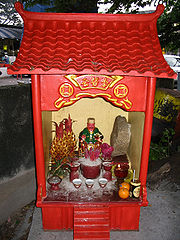
Such lamps are kept burning in shrines, whether private or public, and incense sticks or joss sticks are lit from the lamp.
Archaeological chronology
It is very difficult to say when and where the first oil lamp was used. This is partly because it is difficult to draw a line detailing when the primitive forms of creating a continuous source of light from fire can be termed a lamp.The first lamps were made of naturally occurring objects, coconuts, sea shells, egg shells and hollow stones. Some believe that the first proper lamps were carved from stones. Curved stone lamps were found in places dated to the 10th millennium BCE. (Mesolithic, Middle Stone Age Period, circa 10,300 - 8000 BCE)
Some Archaeologists claim that the first shell-lamps were in existence more than 6,000 years ago. (Neolithic, Later Stone Age, c. 8500 - 4500 BCE). They believe that the alabaster shell-shaped lamps dug up in Sumerian sites dating 2,600 BCE were imitations of real shell-lamps that were used for a long time. (Early Bronze, Canaanite / Bronze I-IV, c.3300 - 2000 BCE)
It is generally agreed that the evolution of handmade lamps moved from bowl-shaped to saucer-shaped, then from saucer with a nozzle, to a closed bowl with a spout.
Chalcolithic Age, c.4500 - 3300 BCE.
The first manufactured red pottery oil lamps appeared. These were of the round bowl type.The Bronze Ages (3200-1200 BCE)
Lamps were simple wheel-made bowls with a slight pinch on four sides for the wick. Later lamps had only one pinch. These lamps vary in the shape of the rim, the general shape of the bowl and the shape of the base.- Intermediate Bronze Age lamps (EBIV/MBI)
The earliest lamps known from Intermediate Bronze Age lamps (EBIV/MBI)
With the four wick lamps. These lamps are made from large bowls with four shallow pinches for wicks.
- Middle Bronze Age lamps (MB)
The four-wick oil lamps persist into this period, most of the lamps now have one wick. Early in this period the pinch is shallow, while later on it becomes more prominent and the mouth protrudes from the lamp's body. The bases are simple and flat. The crude potter’s wheel is introduced, transforming the handmade bowls to a more uniform container. The saucer style evolves into a single spout shape.
- Late Bronze Age lamps (LB)
A more pronounced, deeper single spout is developed, and it is almost closed on the sides. The shape is evolving to be more triangular, deeper and larger. All lamps are now wheel-made. The base is simple, usually flat.
The Iron Age (1200-560 BCE)
The rim becomes wider and flatter with a deeper and higher spout. The tip of the spout is more upright in contrast to the rest of the rim.The lamps are becoming variable in shape and distribution. We still find lamps similar to the Late Bronze period. In addition, other forms evolve, such as small lamps with a flat base and larger lamps with a round base. The later form continues into the Iron Age II.
In the later Iron Age, we encounter variant forms. One common type is small, with a wide rim and a wide base. Another type is a small, shallow bowl with a thick and high discus base.
Persian
These large lamps have thin sides and a deep pinch, which flattens the mouth and makes it protrude outward.Greek
Lamps are more closed to avoid spilling. They are smaller and more refined. Most are handleless. Some are with a lug, pierced and not pierced. The nozzle is elongated. The rim is folded over to make the nozzle, so it overlaps and is then pinched to make the wick hole.They are round in shape, wheel-made.
Early Roman
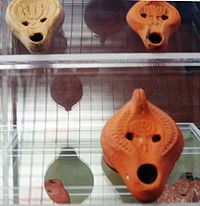
Late Roman
The High Imperial Type. More decorations. Produced locally or imported in large scale. The multiple-nozzled lamps appear. Different varieties.In this period we find the frog type lamps. These are kidney or heart shaped or oval. With the motif of a frog or its abstraction, and sometimes with geometrical motifs. They were produced around 100 AD. They are so variant that it is seldom that two identical ones are found.
Byzantine
.jpg)
Early Islamic
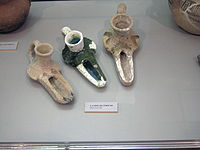
The early Islamic lamps are a continuation of Byzantine lamps. Decorations were initially a stylized form of bird, grain, tree, plant or flower. Then they became entirely geometric or linear with raised dots.
The first kerosene lamp
Kerosene lamp
The kerosene lamp is a type of lighting device that uses kerosene as a fuel. This article refers to kerosene lamps that have a wick and a tall glass chimney. Kerosene lanterns that have a wick and a glass globe are related to kerosene lamps and are included here as well...
was described by al-Razi
Al-Razi
Muhammad ibn Zakariyā Rāzī , known as Rhazes or Rasis after medieval Latinists, was a Persian polymath,a prominent figure in Islamic Golden Age, physician, alchemist and chemist, philosopher, and scholar....
(Rhazes) in 9th century Baghdad
Baghdad
Baghdad is the capital of Iraq, as well as the coterminous Baghdad Governorate. The population of Baghdad in 2011 is approximately 7,216,040...
, who referred to it as the "naffatah" in his Kitab al-Asrar (Book of Secrets).
In the transition period some lamps had Arabic writing. Then, writing disappears until the Mamluk
Mamluk
A Mamluk was a soldier of slave origin, who were predominantly Cumans/Kipchaks The "mamluk phenomenon", as David Ayalon dubbed the creation of the specific warrior...
period (13th - 15th centuries CE).
Land of Israel
- Jerusalem oil lamp: Characteristic black color of the clay because the clay was burned without oxygen. Usually of high quality.
- Daroma oil lamp:
- Jerash oil lamp:
- Nabatean oil lamp:
- Herodian oil lamp: Considered to be used mainly by Jews. Wheel made, rounded. Nozzle with concave sides. The lamps are usually not decorated. If there is decoration, it tends to be simple. Very common throughout all of Israel, and some lamps have also been found in Jordan. Date from 1st century BCE to the end of the 1st century AC.
- Menorah oil lamp, 7 nozzles: Rare and are associated with Judaism because of the numerical connection with the seven branches or arms of the Menorah.
- Samaritan oil lamp: Characterized by a sealed filling hole, which was to be broken by the buyer. This was probably done to ensure ritual purity. A wider spout, and the concavities flanking the nozzle are almost always emphasized with a ladder pattern band. In general the lamps are uncoated. The decorations are linear and/or geometric.
-
- Type I: A distinct channel running from the pouring-hole to the nozzle, a small knob handle, a ladder pattern around the nozzle and shows no ornamentation on the bottom of the base.
- Type II: Pear-shaped and elongated, lined channel that extends from the filling-hole to the nozzle, continued to be used through to the early Muslim period.
- Candle Stick oil lamp: Menorah design on the nozzle and bunch of grapes on the shoulders.
- Byzantine oil lamp: The upper parts are covered with braided patterns and their handles. All are made of a dark orange-red clay. A rounded bottom with a distinct X or cross appears inside the circled base.
- Early Islamic oil lamp: Large knob handle and the channel above the nozzle are dominant elements. The handle is tongue-shaped. Decoration is rich and elegant. The lower parts are extremely broad and the nozzles are pointed.
Importance of oil lamps in India
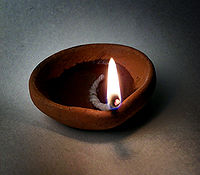
Vedic period
The Vedic period was a period in history during which the Vedas, the oldest scriptures of Hinduism, were composed. The time span of the period is uncertain. Philological and linguistic evidence indicates that the Rigveda, the oldest of the Vedas, was composed roughly between 1700–1100 BCE, also...
, fire was kept alive in every household in some form and carried with oneself while migrating to new locations. Later the presence of fire in the household or a religious building was ensured by an oil lamp. Over the years various rituals and customs were woven around an oil lamp.
Deep Daan, the gift of a lamp was and still is believed to be the best daan. During marriages, spinsters of the household stand behind the bride and groom, holding an oil lamp to ward off the evil. The presence of oil lamp is an important aspect of ritual worship (the shodashopachar puja) offered to a deity. Moreover, a day is kept aside for the worship of the lamp in the busy festival calendar, on one amavasya (no moon) day in the month of Shravan. This reverence for the deep is based on the symbolism of the journey from darkness and ignorance to light and the knowledge of the ultimate reality – 'tamaso ma jyotirgamaya!'
The earlier lamps were made out of stone or seashells. The shape was like a circular bowl with a protruding beak. Later they were replaced by earthen and metal lamps. In the epics Ramayana
Ramayana
The Ramayana is an ancient Sanskrit epic. It is ascribed to the Hindu sage Valmiki and forms an important part of the Hindu canon , considered to be itihāsa. The Ramayana is one of the two great epics of India and Nepal, the other being the Mahabharata...
and Mahabharata
Mahabharata
The Mahabharata is one of the two major Sanskrit epics of ancient India and Nepal, the other being the Ramayana. The epic is part of itihasa....
, there are references of gold and silver lamps as well. The simple shape evolved and the lamps were created in the shapes of the matsya (fish), kurma (boar) and other incarnations of god Vishnu and also in the shape of the many attributes of gods like conch shells, lotuses and so on. The birds like swans, peacocks, parrots and animals like snakes, lions, elephants and horses were also favorites while beautifying a lamp. For lighting multiple lamps, wooden and stone deepastambhas (towers of light) were created. Erecting a deepastambha in front of a temple is still a general practice in western and southern India. For adapting the design to the households and smaller spaces, the deepavriksha (tree of light) was formed. As the name suggests, it is a metal lamp container with aesthetically curvi-linear lines branching out from the base each holding a lamp. The Deepalaxmi is another favorite design where goddess Laxmi holds the lamp in her hands. Kuthuvilakku is another typical lamp traditionally used for house hold purposes in South India.
Oil lamps also became proverbial. For example, a Bradj (pre-Hindi) proverb says, "Chiraag tale andhera", "the [utmost] darkness is under the oil-lamp (chiraag)", meaning that what you seek could be close but unnoticed, in various senses (and indeed, a lamp's container casts shadow)
General
. Huge catalogue in four quarto volumes, THE lamp bible but extremely expensive even second-hand. Referred to as BMC. Superseded by Bailey but still worthwhile and much cheaper if you can find an old copy. Another superb catalogue and excellent reference, perhaps second only to Bailey Less academic than the museum catalogues and short on dating but fairly comprehensive (within its specified area, i.e. not Northern Europe) and extensively illustrated. In French, good coverage of earlier and later lamps in the Louvre, well illustrated. In German, superb catalogue, profusely illustrated and captioned. Useful introduction but illustrations are very poor and beware as several of the items shown have since been exposed as fakes. Excellent introductory booklet, well illustrated. In German, small booklet but excellent illustrations in color. In French, brief guide to a few lamps in the Brussels Museum. Edwardian illustrated article for the Society of Antiquaries of Scotland, interesting insight into the general knowledge of that time.Western Europe
In German, emphasis on local lamps found in Trier but excellent coverage of all Roman types of the Rhineland. Paperback, frustratingly unindexed but a refreshing approach and well worth plowing through. In German, long out-of-print classic but a superb reference if you can find a copy In German, catalogue of lamps. Paperback. In French with short summaries in English, Italian and German. Excellent general survey of lamps, detailed study and catalogue of the small collection of Roman oil lamps at Nyon.Aegean
Good coverage of local lamps. Excellent booklet, profusely illustrated and a recommended reference, very cheap used copies.North Africa
Paperback, lavishly color-illustrated guide to North African red slipware including many lamps. In Italian, detailed catalogue of locally found lamps.See also
- Ancient Roman oil lamp
- List of light sources
- Timeline of lighting technologyTimeline of lighting technologyTimeline of lighting technology- Antiquity :* 70,000 BCE A hollow rock, shell, or other natural found object was filled with moss or a similar material that was soaked in animal fat and then ignited.* c. 4500 BCE oil lamps...
External links
- Romulus2.com, ancient Lamps
- Umanitoba.ca,
- Steve-Adler.com, iil Lamps from the Holy land From the Adler collection iil Lamps of Antiquity
- DigCaesarea.org, The Corpus of Terracotta Lamps From Caesarea Maritima Israel (1971–1980)

